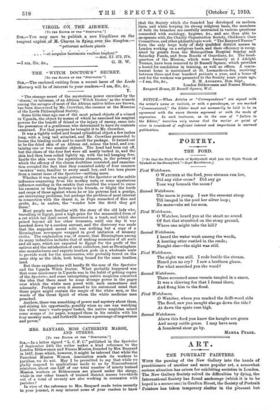ART.
THE PORTRAIT PAINTERS.
WITH the passing of the New Gallery into the hands of practitioners of another and more popular art, a somewhat serious situation has arisen for exhibiting societies in London. The New Gallery Society solved its difficulties by dying, the International Society has found anchorage (which it is to be hoped is a secure one) in Graft= Street, the Society of Portrait Painters has taken temporary shelter in the pleasant but -inadequate room of the Old Water-Colour Society in Pall Mall, and various satellite bodies have disappeared in outer darkness. Compared with twenty years ago, London is now notoriously under-galleried. The Grosvenor, alas ! is but a " greenery-yallery " memory, the New English Art Club's gallery vanished with " England's Home of Mystery " in Piccadilly, and the Prince's Club, where the International Society held its first and best Exhibition, has now given its whole floor to skating. Of the available galleries that are left, every one knows -that they could be booked twice over for ten months of the year. There remains, of course, the premier gallery of London. It lies empty from July to January. What an ideal place it would be for the Portrait Painters I Of course that is impossible,—all desirable and sensible things in art affairs are impossible. But will it always be impossible ? Will it be impossible, for instance, next year P The Royal Academy, I believe, is this year breaking the tradition of a. century by permitting the Town Planning Conference to hold the Exhibition of its plans and cartoons in Burlington House. This generous step will be hailed with such general appreciation that the Royal Academy may be in a mood to consider the putting of its gallery, or part of it, to a good use next October and November, when the Portrait Painters will in all probability again be faced by the choice between a diminutive Exhibition and dissolution. Previous suggestions made to the Royal Academy to give house-room for other art societies placed that body in the position of having first to overcome the natural human fear that such a course might not be fair to itself. In the case of the Portrait Painters, the Royal Academy's generous desire for the spread of the influence of Art, and its worthy apprehension that it is by the grace of King George III. her official protector in England, need not be weakened by any such anxiety. The late President of the Portrait Painters was Sir W. Q. Orchardson, and a very large proportion of the members are either Academicians or Associates or regular exhibitors at Bur- lington House. Nowadays nearly all our painters try their brains and hands at portraiture—it is a well-known fact that some Academicians are able to charge an extra fee to those sitters whose portraits they agree to include in their Academy contribution—and several of them have always looked to the New Gallery Society and to the Portrait Painters for exhibiting ground for their surplus portraits. With a full display of pictures from the present members, and a " retrospective " stiffening from past portrait painters, the Society could produce an Exhibition at once stimulating to artists and to the public. It is hardly necessary to point out that of all classes of painting, portraiture most immediately depends on public exhibition and on a spacious setting.
At the present Exhibition of the Portrait Painters there is evidence that the Committee were rather at the mercy of circumstances. A number of the more prominent members are not represented, and some of the pictures have made a fairly recent appearance in London. Of the latter section, Mr. Francis Dodd's portrait of Mr. Henry Lamb (No. 32), displaying his almost furious instinct for character with a nervous force of handling that is less common in his work, and Sir L. Alma Tadema's portrait of his daughter (No. 12) .---painted many years ago—with its subdued skill and curious suggestion of Pre-Raphaelitism without passion, afford a most interesting contrast. Mr. E. A. Walton's portrait of Sir William Crookes (No. 6)—one of the finest male portraits
painted in years—is a telling example of the portraiture done in Britain that is never seen in the Royal Academy. Mr. Walton has now disciplined himself to a grip of form and characterisation that allows us fully to enjoy his charming gift for colour, but the handling of his background suggests that discipline might yet be pressed a step further. Mr. J. J. Shannon's bust of Mr. J. -Sampson (No. 16) is a very attractive work despite that curious shine which this artist seems so frequently tO discern on his sitter's face. A head of a boy by Mr. G. Spencer Watson (No. 1), a finely realised head of an aged man by Mr. P. Bigland (No. 23), Mr. W. W. Russell's Norman' Hardy (No. 27), Mr. Bowie's B. Miller, Esq. (No. 29), Mr. Harris .Brown's Mrs. Seaman (No. 17),- Mr. Harold Speed's sketch portrait (No. 39), and Mr. W. Strang's The Violinist (No. 41) are all serious and interesting examples of contemporary portraiture. 31Er. John Lavery exhibits three portraits of which the one-that best displays his gifts
is the sketch of Anna Pavlova, the Russian dancer (No. 7), with its swift grace in movement and expression and its accent of romance. Most interesting of all is a small portrait of Sir W. Q. Orchardson by his old fellow-pupil, Tom Graham (No. 45),—a memorial and epitome of the Edinburgh school of painting to which they both belonged. J. B.



























































 Previous page
Previous page